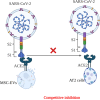Extracellular vesicles derived from mesenchymal stem cells - a novel therapeutic tool in infectious diseases
- PMID: 36849892
- PMCID: PMC9970864
- DOI: 10.1186/s41232-023-00266-6
Extracellular vesicles derived from mesenchymal stem cells - a novel therapeutic tool in infectious diseases
Abstract
Extracellular vesicles (EVs) are nano-sized lipid-bilayer encapsulated vesicles produced by the cells. These EVs are released into the surrounding space by almost all cell types. The EVs help in intercellular communication via their payloads which contain various proteins, lipids, and nucleic acids generated from the donor cells and allow for synergistic responses in surrounding cells. In recent years, EVs have been increasingly important in treating infectious diseases, including respiratory tract infections, urinary tract infections, wound infections, sepsis, and intestinal infections. Studies have confirmed the therapeutic value of mesenchymal stem cell-derived EVs (MSC-EVs) for treating infectious diseases to eliminate the pathogen, modulate the resistance, and restore tissue damage in infectious diseases. This can be achieved by producing antimicrobial substances, inhibiting pathogen multiplication, and activating macrophage phagocytic activity. Pathogen compounds can be diffused by inserting them into EVs produced and secreted by host cells or by secreting them as microbial cells producing EVs carrying signalling molecules and DNA shielding infected pathogens from immune attack. EVs play a key role in infectious pathogenesis and hold great promise for developing innovative treatments. In this review, we discuss the role of MSC-EVs in treating various infectious diseases.
Keywords: Exosomes; Extracellular vesicles; Mesenchymal stem cells; Stem cell therapy; Wound infections.
© 2023. The Author(s).
Conflict of interest statement
The authors declare that they have no competing interests.
Figures






Similar articles
-
Mechanism and Potential of Extracellular Vesicles Derived From Mesenchymal Stem Cells for the Treatment of Infectious Diseases.Front Microbiol. 2021 Oct 26;12:761338. doi: 10.3389/fmicb.2021.761338. eCollection 2021. Front Microbiol. 2021. PMID: 34764947 Free PMC article. Review.
-
The Role of Extracellular Vesicles from Human Macrophages on Host-Pathogen Interaction.Int J Mol Sci. 2021 Sep 23;22(19):10262. doi: 10.3390/ijms221910262. Int J Mol Sci. 2021. PMID: 34638604 Free PMC article. Review.
-
Therapeutic potential of mesenchymal stem cell-derived extracellular vesicles as novel cell-free therapy for treatment of autoimmune disorders.Exp Mol Pathol. 2021 Feb;118:104566. doi: 10.1016/j.yexmp.2020.104566. Epub 2020 Nov 6. Exp Mol Pathol. 2021. PMID: 33160961 Review.
-
Extracellular Vesicles in Physiology, Pathology, and Therapy of the Immune and Central Nervous System, with Focus on Extracellular Vesicles Derived from Mesenchymal Stem Cells as Therapeutic Tools.Front Cell Neurosci. 2016 May 2;10:109. doi: 10.3389/fncel.2016.00109. eCollection 2016. Front Cell Neurosci. 2016. PMID: 27199663 Free PMC article. Review.
-
Mesenchymal stromal cell-derived extracellular vesicles: regenerative and immunomodulatory effects and potential applications in sepsis.Cell Tissue Res. 2018 Oct;374(1):1-15. doi: 10.1007/s00441-018-2871-5. Epub 2018 Jun 28. Cell Tissue Res. 2018. PMID: 29955951 Review.
Cited by
-
Cellular In Vitro Responses Induced by Human Mesenchymal Stem/Stromal Cell-Derived Extracellular Vesicles Obtained from Suspension Culture.Int J Mol Sci. 2024 Jul 11;25(14):7605. doi: 10.3390/ijms25147605. Int J Mol Sci. 2024. PMID: 39062847 Free PMC article.
-
Injectable extracellular vesicle hydrogels with tunable viscoelasticity for depot vaccine.Nat Commun. 2025 Apr 22;16(1):3781. doi: 10.1038/s41467-025-59278-0. Nat Commun. 2025. PMID: 40263275 Free PMC article.
-
Impact of Canine Amniotic Mesenchymal Stem Cell Conditioned Media on the Wound Healing Process: In Vitro and In Vivo Study.Int J Mol Sci. 2023 May 4;24(9):8214. doi: 10.3390/ijms24098214. Int J Mol Sci. 2023. PMID: 37175924 Free PMC article.
-
Wharton's Jelly mesenchymal stem cell-derived extracellular vesicles induce liver fibrosis-resolving phenotype in alternatively activated macrophages.J Cell Mol Med. 2024 Sep;28(18):e18507. doi: 10.1111/jcmm.18507. J Cell Mol Med. 2024. PMID: 39288445 Free PMC article.
-
Tumour-associated macrophages in gastric cancer: From function and mechanism to application.Clin Transl Med. 2023 Aug;13(8):e1386. doi: 10.1002/ctm2.1386. Clin Transl Med. 2023. PMID: 37608500 Free PMC article. Review.
References
Publication types
LinkOut - more resources
Full Text Sources
Other Literature Sources

